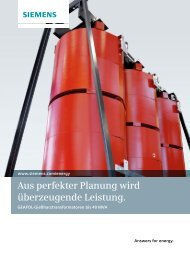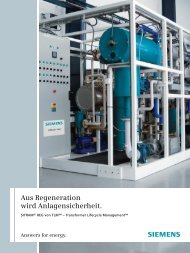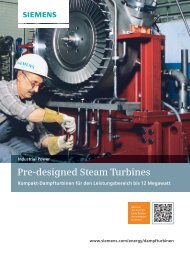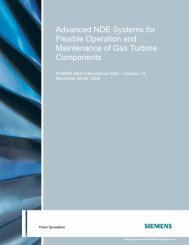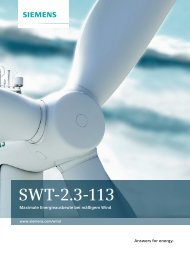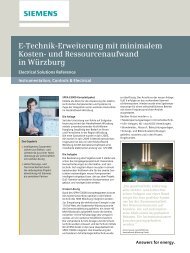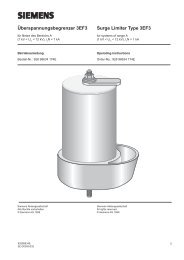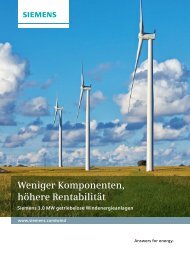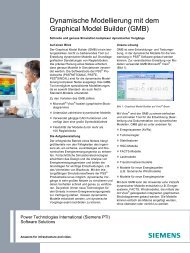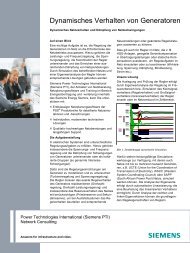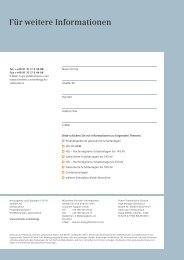50-Hz Heavy Duty Gas Turbines – Experience ... - Siemens Energy
50-Hz Heavy Duty Gas Turbines – Experience ... - Siemens Energy
50-Hz Heavy Duty Gas Turbines – Experience ... - Siemens Energy
Create successful ePaper yourself
Turn your PDF publications into a flip-book with our unique Google optimized e-Paper software.
Final<br />
<strong>50</strong>-<strong>Hz</strong> <strong>Heavy</strong> <strong>Duty</strong> <strong>Gas</strong> <strong>Turbines</strong> <strong>–</strong><br />
<strong>Experience</strong> and Evolution<br />
Hans Maghon,<br />
Bernd Stöcker<br />
Dietmar Granser<br />
<strong>Siemens</strong> Power Generation (PG),<br />
Germany<br />
© <strong>Siemens</strong> AG 2005. All rights reserved.<br />
- 1
Final<br />
Introduction<br />
Permanently increasing market requirements for combined cycle power plants, in terms of<br />
performance, efficiency, emissions, operational flexibility and life cycle cost, are driving<br />
forces in the power industry demanding a continuous development process. Especially the<br />
gas turbine, as the core component of a combined cycle power plant, is affected by this<br />
requirement.<br />
This paper describes the latest evolutionary step of the largest <strong>Siemens</strong> gas turbine <strong>–</strong> the<br />
SGT5-4000F, formerly known as V94.3A <strong>–</strong> along with the associated commercial operating<br />
experience. Adhering to its proven and mature design, the performance characteristics of the<br />
SGT5-4000F have been enhanced, resulting in higher component efficiencies due to better<br />
compressor and turbine aerodynamics and in greater gas turbine output.<br />
Incremental improvements of the combustion aerodynamics reflect the potential towards<br />
lower emissions, higher operational flexibility and even further enhanced performance. The<br />
paper will conclude with a review of the latest SGT5-4000F operating experience, including<br />
demonstrated customer benefits from the further refinement of the combustion system.<br />
The evolutionary approach is not only used to further increase the performance of existing<br />
products like the SGT5-4000F, but is also utilized to create new products to meet specific<br />
market requirements. This will be shown in the example of the SGT5-3000E (formerly<br />
known as V94.2A).<br />
Derived from the larger F-class model, the lower rated SGT5-3000E is tailored to meet the<br />
intermediate output market requirements. This machine is characterized by the same<br />
technical platform and the same proven concept as the SGT5-4000F. Targeting the same high<br />
reliability and even better availability, the SGT5-3000E is optimized for simple cycle and<br />
combined applications in the 190 MW / 5<strong>50</strong> MW classes, respectively.<br />
SGT5-4000F<br />
The SGT5-4000F gas turbine concept builds on more than forty years’ experience with heavy<br />
duty gas turbines at <strong>Siemens</strong>. Since its market introduction in 1996, the SGT5-4000F fleet<br />
and its three smaller sister models SGT6-4000F, SGT5-3000E and SGT 1000F (formerly<br />
V84.3A, V94.2A and V64.3A) have accumulated over 2.7 million Equivalent Operating<br />
Hours (EOH) with 120 units in service. With more than 47 engines on order, this fleet is still<br />
growing at a rapid pace.<br />
© <strong>Siemens</strong> AG 2005. All rights reserved.<br />
- 2
Final<br />
The evaluation of the reliability and availability statistics reveals the excellent operating<br />
experience of this GT type. The data is based on statistical evaluation of customer feedback<br />
via GEB (<strong>Gas</strong>turbinen-Erfahrungs-Bericht), a customer self-analysis of key operational data<br />
reported to <strong>Siemens</strong> monthly, typically provided by about 60 to 70% of the fleet.<br />
The reliability level of the SGT5-4000F engines has been above 99% for five consecutive<br />
years. Comparing this record with other mature frames, such as the SGT5-2000E (formerly<br />
known as V94.2), which was introduced in the early 80’s, shows that the SGT5-4000F engine<br />
can clearly be considered a mature product based on proven technology.<br />
Availability levels are typically above 94%, depending on the percentage of engines that have<br />
a major revision in the period. These numbers also reflect the maturity and high service<br />
friendliness of this GT type, meeting planned outage intervals and short outage durations.<br />
It should be noted that the above numbers do not only represent the top percentage of the fleet<br />
but the fleet average of all engines with sufficient GEB feedback.<br />
SGT5-4000F Latest Upgrade<br />
The mature SGT5-4000F has been continuously improved and upgraded over the past years<br />
since its market introduction 1996. These improvements and upgrades have followed an<br />
evolutionary path, which means that they are based on rather small design changes, while<br />
keeping proven features and technologies. They are typically based on positive field<br />
experience showing additional potential for higher loading of components or utilizing already<br />
built-in design margins, as well as additional improvements that can be found with more<br />
sophisticated design tools or new but already validated and tested technologies.<br />
Modified parts and design features are thoroughly examined in test rigs and/or a test bed<br />
engine. Even though these tests provide good confidence that the parts will meet their design<br />
intent, they typically lack long-term experience, which can be a significant market<br />
introduction hurdle. Therefore, a number of measures were selected and bundled to be used<br />
in a long-term demonstration run at a selected customer site to gain additional long term<br />
experience.<br />
These latest gas turbine upgrade measures include:<br />
• Slightly re-designed compressor blades and vanes on Stages 1 and 2 and inlet guide<br />
vanes for increased massflow.<br />
© <strong>Siemens</strong> AG 2005. All rights reserved.<br />
- 3
Final<br />
• Row 4 turbine blades re-staggered to reduce aerodynamic losses at increased mass<br />
flow.<br />
• Re-design of improved Ceramic Heat Shield (CHS) material to reduce service cost by<br />
lowering the fallout rate.<br />
• Changes to operating parameters to operate in premix mode even at turndown below<br />
<strong>50</strong>% base load and within required emissions limits.<br />
• World-first installation of a Hydraulic Clearance Optimization (HCO) system to<br />
control turbine blade-tip clearances, resulting in increased power and efficiency.<br />
The aerodynamic characteristics of the first two compressor stages and the inlet guide vane<br />
were modified to increase compressor inlet mass flow associated with an increase in<br />
efficiency. The airfoil geometry was adapted to the existing flow channel and the rotor disc<br />
slots. Thus, the new blades and vanes are fully retrofittable. They were easily implemented<br />
in Mainz-Wiesbaden, the site selected for the long term demonstration run, and are also<br />
available as a service upgrade for other existing engines.<br />
To also adapt the turbine to the higher flow, the last stage blade was re-staggered by 1.5°.<br />
This was achieved by a simple casting change by turning the existing airfoil on the existing<br />
blade root. With this measure, aerodynamic losses could be reduced without major requalification<br />
efforts for the modified casting and without significant changes to blade<br />
vibration behavior.<br />
Tight radial clearances in both the compressor and the turbine section is one key to high<br />
component efficiencies. However, under any operating condition, some radial clearance must<br />
be maintained in order to avoid contact between rotating and stationary parts. The solution<br />
lies in striking a favorable balance between the warm-up and cool-down behavior of the<br />
casing and rotor components. The rotor, which typically has the slower thermal response, can<br />
be heated and cooled quickly by internal secondary airflows.<br />
The conical flow path in the turbine casing of the <strong>Siemens</strong> frames gives another opportunity<br />
to introduce clearance control by combining axial and radial growth. It facilitates active<br />
clearance control by shifting the rotor against the flow direction and consequently reducing<br />
the radial gaps above the turbine blade tips.<br />
Even though the SGT5-4000F already has a very good thermal balance allowing for tight<br />
clearances, once the engine is fully heated and running at base load, the clearances are larger<br />
© <strong>Siemens</strong> AG 2005. All rights reserved.<br />
- 4
Final<br />
than required. This is because the clearances are designed for hot restart conditions, which is<br />
the most critical operation mode. Furthermore, clearances need to be large enough to account<br />
for casing ovalization during heat up.<br />
These two effects, hot restart capability and casing ovalization, lead to the fact that turbine<br />
clearances can be reduced after the engine is fully heated.<br />
The HCO uses this potential by shifting the rotor in the compressor direction after the engine<br />
is fully heated and thus, reduces the radial clearances by about one millimeter. It can be<br />
shown that the efficiency gain in the turbine of about 0.35%points is far larger than the loss in<br />
the compressor section of about 0.15%points due to slightly increased clearances.<br />
The design of the HCO allows for only two positions. HCO is either switched on or off and<br />
the positioning is ensured by mechanical stops in the hydraulic cylinders. There is no need<br />
for a closed loop control circle with position measurement. Just by applying the oil pressure,<br />
the rotor moves automatically into the right position. As the axial thrust of the gas turbine is<br />
directed in the turbine direction, the system is even fail safe. In the unlikely event of a<br />
pressure loss, the axial thrust would move the rotor back into the “safe” position.<br />
Operating <strong>Experience</strong> at Mainz-Wiesbaden with the Upgraded SGT5-4000F<br />
All of these optimization measures were implemented at the Mainz-Wiesbaden power plant<br />
between 2002 and 2004. The gas turbine’s output was increased by eight megawatts and its<br />
efficiency boosted by 0.3 percentage points. However, this enhancement is “bought” at the<br />
expense of an exhaust temperature that is about four to five degrees Kelvin lower. Depending<br />
on the design of the boiler, the benefit for the entire combined cycle is 0.1 to 0.2 percent<br />
points. These measures have now been in place for over 11,000 operating hours, and it has<br />
since become field-proven technology that is also recognized by insurance companies.<br />
Through the increase in mass flow rate, combined-cycle output increases in total by between<br />
11 and 12 megawatts.<br />
Extrapolated for a new power plant (under the same boundary conditions as in Mainz), an<br />
efficiency of over 58.5 percent in combined-cycle duty would result, given the multifaceted<br />
improvements implemented at the Mainz-Wiesbaden power plant. For <strong>Siemens</strong> PG and the<br />
customer KMW, the intensive cooperation that has developed is a win-win situation: KMW<br />
has, at its disposal, a power plant that represents the latest state of the art, while <strong>Siemens</strong> has<br />
the opportunity to test and assess the iterative steps of new developments in the power plant in<br />
real-life operation.<br />
© <strong>Siemens</strong> AG 2005. All rights reserved.<br />
- 5
Final<br />
In the two one-year demonstration periods, as agreed between KMW and <strong>Siemens</strong>, the<br />
upgrade features were implemented and tested:<br />
Phase 1 from summer 2002 to summer 2003 focusing on hot gas path improvements.<br />
Phase 2 from summer 2003 to summer 2004 implementing the mass flow increase, HCO<br />
and turndown.<br />
In addition to an extensive measurement program, both test phases included a sequence of<br />
planned inspections to visually examine the new parts. These inspections were scheduled in<br />
close cooperation between <strong>Siemens</strong> and KMW to achieve all required testing and inspection<br />
results while minimizing the commercial impact for the customer.<br />
The new compressor design was validated by numerous measurements for blade vibration to<br />
confirm dynamic behavior and mechanical integrity as well as pressure and temperature<br />
measurements to verify the aero-dynamic design intent.<br />
Blade vibrations were monitored by strain gages on the airfoils and laser probes for noncontact<br />
vibration measurement (BSSM <strong>–</strong> Berührungslosenschaufelschwingungsmessung), not<br />
only at <strong>50</strong>-<strong>Hz</strong> grid frequency but also at over and under speed during several Full-Speed No-<br />
Load (FSNL) runs without being synchronized to the grid.<br />
It was verified that the required blade frequencies were met with sufficient margin to the<br />
harmonics of engine speed and that the measured vibrations were well below the allowable<br />
ranges.<br />
With more than one year of operation, a wide variety of ambient conditions have been seen,<br />
from about <strong>–</strong>8°C to +35°C, and the upgraded compressor met and exceeded expectations.<br />
As expected after such a successful design validation, the visual inspections showed no<br />
negative findings on the blading.<br />
Even though the engine is designed for a 308 MW mechanical load limit, only 281 had been<br />
demonstrated before the KMW testing series due to lack of tests at very low ambient<br />
conditions. It is <strong>Siemens</strong>’ design philosophy to release only the maximum power that has<br />
been previously demonstrated in an engine equipped with BSSM on Turbine Blade 4 to<br />
validate that no blade flutter might occur and that blade vibrations are within the allowable<br />
limit.<br />
The new re-staggered Blade 4 had been BSSM tested in Mainz-Wiesbaden and showed no<br />
significantly different vibration behavior compared to the previous design. That confirmed<br />
the expectation, as the design change was very minor.<br />
© <strong>Siemens</strong> AG 2005. All rights reserved.<br />
- 6
Final<br />
With the increased mass flow, the old released load limit of 281 MW could be enhanced even<br />
though winters are rather mild in Mainz-Wiesbaden. During a test run at an ambient<br />
temperature of minus 8°C, the power was successfully increased to 301 MW.<br />
A special focus was given to the validation of the HCO, as this was the first application to a<br />
commercial engine after a successful run in the test bed engine in Berlin in 2001.<br />
During commissioning after implementation in summer 2003, the operation and control<br />
settings were optimized.<br />
The validation of upgrade features usually has the difficulty that the features are implemented<br />
together with other changes to the engine, and improvements have to be calculated by<br />
comparison of test runs before and after the implementation. However, the testing with HCO<br />
was different as this feature can be switched on and off during operation even at full base<br />
load. This way, HCO benefit can be directly measured. In one test run, the fuel mass flow<br />
and the compressor inlet mass flow were held constant. Then, HCO was switched on and it<br />
was directly observed that the power increased while the fuel mass flow remained unchanged.<br />
GT power was increased by about 1.5 MW at constant fuel consumption. This reflects a GT<br />
efficiency increase of about 0.3 percentage points. As the additional power is actually taken<br />
out of the exhaust energy, the impact on the combined cycle performance is slightly lower but<br />
still close to 1 MW more power and about 0.1 to 0.2 percent points on efficiency, depending<br />
on the boiler characteristics.<br />
An online clearance measurement monitored the rotor movement and was also helpful in<br />
demonstrating the potential for clearance reduction when a hot restart was performed. When<br />
HCO is switched on, the clearances are not smaller than during a hot restart. In the fleet,<br />
numerous hot restarts have been demonstrated over the past years without any rubbing issues.<br />
During the one year testing period, the HCO was always functional and no GT trip was<br />
caused by the system. After some weeks of operation, it was observed that the hydraulic<br />
pumps that generate the static pressure started to switch on more frequently to build up the<br />
pressure that is maintained by a pressure accumulator, which indicated a very slight oil<br />
leakage. The full functionality of the HCO was maintained during the whole one-year period<br />
without risk, as the pumps are designed to run full time.<br />
In parallel, the root cause was identified as a combination of a slightly higher than specified<br />
temperature of the hydraulic pistons in combination with the turbine oil specification. Jointly<br />
with the seal manufacturer, a different type of seal ring material was selected and<br />
implemented after one year of test operation. Since then, no further oil leakage has occurred.<br />
On the contrary, the seals proved to be so tight that the switching procedure needed to be<br />
© <strong>Siemens</strong> AG 2005. All rights reserved.<br />
- 7
Final<br />
revised to avoid overpressure warnings during filling of the cylinders on one side of the thrust<br />
bearing while cylinders on the other side are drained.<br />
The inspection further showed that all other parts of the bearing had no negative findings.<br />
The piston surfaces were in excellent condition and no deformation or cracking of any part<br />
could be seen.<br />
SGT5-4000F - Next Steps<br />
In Phase 1, the engine was already prepared for higher temperatures in the future by<br />
improving hot gas parts based on operating experience from the large and continuously<br />
growing fleet.<br />
Actually, the engine was even run most of the time with an increased ISO turbine inlet<br />
temperature of up to 20K above standard rating.<br />
The key to achieving this is twofold. On the one hand, combustor cooling air consumption<br />
needs to be reduced to keep flame temperature constant to avoid increase of NO x emissions.<br />
On the other hand, the burner needs to be improved towards higher stable loads.<br />
Reduction of combustor cooling air consumption can be achieved by applying a new type of<br />
holder for the ceramic tiles. In the current design, the tile holders are cooled from the back in<br />
the area of the tile holder neck and that cooling air also works as seal air to protect the tile<br />
holder heads from hot gas ingestion. The new design is slightly modified so that the<br />
impingement jet directly cools the tile holder head, which is the most critical position. With<br />
the so-called Impingement Cooled Tile Holder (ICTH), a reduction of cooling air<br />
consumption of about 2 % compressor inlet mass flow is envisioned. A limited number of<br />
ICTHs have already been installed in the combustor since summer 2004 and have shown very<br />
good results for more than 4000 EOH. Consequently, the next steps will be to equip the<br />
whole combustor with that new design.<br />
On the burner side, <strong>Siemens</strong> has taken several different approaches to improve not only<br />
combustion stability but also to reduce NO x emissions and to allow for operation with heated<br />
fuel.<br />
Incremental improvements of the combustion aerodynamics reflect the potential towards<br />
lower emissions, higher operational flexibility and even further enhanced performance.<br />
The burner version now implemented in Mainz-Wiesbaden, allows for higher flame<br />
temperatures leading to increased power and efficiency. Also, the fuel gas preheat<br />
temperature could be increased to boost efficiency by approximately 0.3 percentage points.<br />
© <strong>Siemens</strong> AG 2005. All rights reserved.<br />
- 8
Final<br />
A further refinement of the burner design is ongoing. The combination of the achievements of<br />
Mainz-Wiesbaden with other improvements that were tested at other sites will finally lead to a<br />
new burner version with even further performance enhancements.<br />
SGT5-3000E <strong>–</strong> The Derated Daughter<br />
The SGT5-3000E development started at the end of 2002. It is designed to cover the 1<strong>50</strong> to<br />
200 MW power range in the <strong>50</strong>-<strong>Hz</strong> market. Utilizing the excellent reliability and availability<br />
of the SGT5-4000F, the 3000E was derived from this engine by decreasing the compressor<br />
mass flow and the turbine inlet temperature. Following a common parts concept, as many<br />
components as possible of the SGT5-4000F were left unchanged. To achieve compressor<br />
mass flow reduction, the compressor vanes were re-staggered and adjusted. To increase the<br />
surge margin especially for high ambient temperatures, the first stage blade row was slightly<br />
modified, but the stagger angle was maintained. To improve turbine efficiency, the row one<br />
vane was slightly re-staggered. The casting tolerances of this vane are such that a requalification<br />
of the casting process was unnecessary. Because all other hot gas path<br />
components remained unchanged and the turbine inlet temperature was reduced, the service<br />
intervals between major overhauls could be extended to 33000 EOH for the higher power<br />
output and 41000 EOH for the lower power output, leading to an increase in availability and a<br />
reduction in service cost. Much attention was given to cooling air savings for further NOx<br />
emission reduction.<br />
The first gas turbines were introduced at BASF in Ludwigshafen. The combined heat and<br />
power plant (CHP) contains two gas turbines with a heat recovery steam generator and a back<br />
pressure steam turbine. The gas turbines deliver 185 MW each and the steam turbine 80 MW.<br />
Besides power production, the main objective of the power plant is to supply 181 kg/s process<br />
steam for BASF’s chemical plant. The steam is tapped from three different pressure and<br />
temperature levels.<br />
During commissioning, one prototype engine was equipped with measurement<br />
instrumentation. The aim was to guarantee safe operation and verify the design targets.<br />
Low load of the compressor blading during start up and shut down as well as during speed<br />
variations between 94% - 108% of rated speed and up to 108% of rated mass flow were<br />
demonstrated. Due to cooling air optimization of vane rows two and three, additional cooling<br />
air savings and therefore, efficiency improvements and emission reduction were achieved.<br />
The first gas turbine in Ludwigshafen had first fire at the beginning of December 2004 and<br />
the second followed at the middle of the month. All measurements were carried out during<br />
© <strong>Siemens</strong> AG 2005. All rights reserved.<br />
- 9
Final<br />
commissioning. No problems were experienced during commissioning, and the gas turbine<br />
performance with respect to power output, efficiency and NOx emissions exceeded<br />
expectations. The plant was handed over to BASF at the end of April 2005.<br />
Due to the common parts concept, any modification and improvement developed for the<br />
SGT5-4000F as well as experience gained can be implemented one by one into the SGT5-<br />
3000E, thus saving time and cost. In case a future power increase is required by the customer,<br />
the SGT5-3000E can easily be upgraded to an SGT5-4000F.<br />
Conclusion<br />
<strong>Siemens</strong>’ mature product, the SGT5-4000F, was upgraded by evolutionary steps while<br />
maintaining the proven design and technology. All features were intensively tested and<br />
validated in a lead engine made possible by successful cooperation with the customer<br />
Kraftwerke Mainz-Wiesbaden.<br />
The project became a clear win-win situation for both parties. <strong>Siemens</strong> benefited from the<br />
testing opportunity, while KMW benefited from the performance enhancements of its engine.<br />
Measurements confirmed that the design intent was fully met and, in several regards, even<br />
overachieved. Planned inspections were used for visual examinations and showed the proper<br />
function and excellent condition of the new parts. Further improvements were derived from<br />
operating experience for the HCO and have, meanwhile, also been successfully demonstrated.<br />
The upgraded design has become standard for newly built SGT5-4000F gas turbines.<br />
Further evolutionary improvements, especially in the field of combustor and burner<br />
technology, are on their way and will be introduced in similar scenarios leading to even<br />
higher customer benefit while keeping proven design features.<br />
The evolutionary development approach was also very successfully used to derive the SGT5-<br />
3000E from the proven and mature SGT5-4000F using about 95% common parts. The design<br />
goals were achieved or even overachieved while using proven design features and<br />
technologies of the SGT5-4000F. This leads to a very attractive product which will have the<br />
same high reliability and even better availability due to longer maintenance intervals.<br />
© <strong>Siemens</strong> AG 2005. All rights reserved.<br />
- 10



